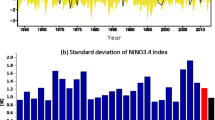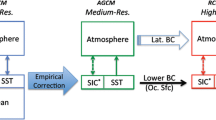Abstract
We evaluate the representation of dynamic sea surface height (SSH) fields of 33 global coupled models (GCMs) contributed to the fifth phase of the Coupled Model Intercomparison Project (CMIP5). We use observations from satellite altimetry and basic performance metrics to quantify the ability of the GCMs to replicate observed SSH of the time-mean, seasonal cycle, and inter-annual variability patterns. The time-mean SSH representation has markedly improved from CMIP3 to CMIP5, both in terms of overall reduction in root-mean square differences, and in terms of reduced GCM ensemble spread. Biases of the time-mean SSH field in the Indian and Pacific Ocean equatorial regions are consistent with biases in the zonal surface wind stress fields identified with independent measurements. In the Southern Ocean, the latitude of the maximum meridional gradient of the zonal mean SSH CMIP5 models is shifted equatorward, consistent with the GCMs’ spatial biases in the maximum of the zonal mean westerly surface wind stress fields. However, while the Southern Ocean SSH gradients correlate well with the maximum Antarctic circumpolar current transports, there is no significant correlation with the maximum zonal mean wind stress amplitudes, consistent with recent findings that the eddy parameterisations in GCMs dominate over wind stress amplitudes in this region. There is considerable spread across the CMIP5 ensemble for the seasonal and interannual SSH variability patterns. Because of the short observational period, the interannual variability patterns depend on the time-period over which they are derived, while no such dependency is found for the time-mean patterns. The model performance metrics for SSH presented here provide insight into GCM shortcoming due to inadequate model physics or processes. While the diagnostics of CMIP5 GCM performance relative to observations reveal that some models are clearly better than others, model performance is sensitive to the spatio-temporal scales chosen.










Similar content being viewed by others
References
Bellenger H, Guilyardi E, Leloup J, Lengaigne M, Vialard J (2013) ENSO representation in climate models: from CMIP3 to CMIP5. Clim Dyn 1–20. doi:10.1007/s00382-013-1783-z
Boning CW, Dispert A, Visbeck M, Rintoul SR, Schwarzkopf FU (2008) The response of the Antarctic circumpolar current to recent climate change. Nat Geosci 1(12):864. doi:10.1038/ngeo362
Cai W, Cowan T (2013) Why is the amplitude of the Indian Ocean dipole overly large in CMIP3 and CMIP5 climate models? Geophys Res Lett :n/a–n/a. doi:10.1002/grl.50208
Carman JC, McClean JL (2011) Investigation of IPCC AR4 coupled climate model North Atlantic mode water formation. Ocean Model 40(1):14. doi:10.1016/j.ocemod.2011.07.001 URL http://www.sciencedirect.com/science/article
Church J, White N (2011) Sea-level rise from the late 19th to the early twenty-first century. Surv Geophys 32:585. doi:10.1007/s10712-011-9119-1
Ducet N, Le Traon PY, Reverdin G (2000) Global high-resolution mapping of ocean circulation from TOPEX/Poseidon and ERS-1 and-2. J Geophys Res 105(C8):19477. doi:10.1029/2000JC900063
Farrell WE, Clark JA (1976) On postglacial sea level. Geophys J Int 46(3):647. doi:10.1111/j.1365-246X.1976.tb01252.x
Gent PR, McWilliams JC (1990) Isopycnal mixing in ocean circulation models. J Phys Oceanogr 20:150. doi:10.1175/1520-0485(1990)020<0150:IMIOCM>2.0.CO;2
Gill AE (1982) Atmosphere-ocean dynamics. International geophysics series. Academic Press, New York
Gleckler PJ, Taylor KE, Doutriaux C (2008) Performance metrics for climate models. J Geophys Res 113(D6):D06104. doi:10.1029/2007JD008972
Gleckler PJ, Santer BD, Domingues CM, Pierce DW, Barnett TP, Church JA, Taylor KE, AchutaRao KM, Boyer TP, Ishii M, Caldwell PM (2012) Human-induced global ocean warming on multidecadal timescales. Nat Clim Change 2(7):524. doi:10.1038/nclimate1553
Greatbatch RJ (1994) A note on the representation of steric sea level in models that conserve volume rather than mass. J Geophys Res 99(C6):12767
Griffies SM (1998) The Gent-McWilliams skew flux. J Phys Oceanogr 28:831. doi:10.1175/1520-0485(1998)028<0831:TGMSF>2.0.CO;2
Griffies SM, Greatbatch RJ (2012) Physical processes that impact the evolution of global mean sea level in ocean climate models. Ocean Model 51(0):37. doi:10.1016/j.ocemod.2012.04.003 URL http://www.sciencedirect.com/science/article
Griffies S, Adcroft A, Aiki H, Balaji V, Bentson M, Bryan F, Danabasoglu G, Denvil S, Drange H, England M, Gregory J, Hallberg R, Legg S, Martin T, McDougall T, Pirani A, Schmidt G, Stevens D, Taylor K, Tsujino H (2009) Sampling physical ocean fields in wcrp cmip5 simulations: clivar working group on ocean model development (wgomd) committee on cmip5 ocean model output. Tech. rep., CLIVAR / WGOMD URL http://nldr.library.ucar.edu/repository/collections/OSGC-000-000-002-965
Hay CC, Morrow E, Kopp RE, Mitrovica JX (2012) Estimating the sources of global sea level rise with data assimilation techniques. Proc Nat Acad Sci. doi:10.1073/pnas.1117683109 URL http://www.pnas.org/content/early/2012/04/26/1117683109.abstract
Jiang JH, Su H, Zhai C, Perun VS, Del Genio A, Nazarenko LS, Donner LJ, Horowitz L, Seman C, Cole J, Gettelman A, Ringer MA, Rotstayn L, Jeffrey S, Wu T, Brient F, Dufresne JL, Kawai H, Koshiro T, Watanabe M, Lcuyer TS, Volodin EM, Iversen T, Drange H, Mesquita MDS, Read WG, Waters JW, Tian B, Teixeira J, Stephens GL (2012) Evaluation of cloud and water vapor simulations in CMIP5 climate models using NASA “A-Train” satellite observations. J Geophys Res 117(D14):D14105. doi:10.1029/2011JD017237
Jourdain N, Gupta A, Taschetto A, Ummenhofer C, Moise A, Ashok K (2013) The Indo-Australian monsoon and its relationship to ENSO and IOD in reanalysis data and the CMIP3/CMIP5 simulations. Clim Dyns :1–30. doi:10.1007/s00382-013-1676-1
Knutti R (2010) The end of model democracy?. Clim Change 102:395. doi:10.1007/s10584-010-9800-2
Kopp R, Mitrovica J, Griffies S, Yin J, Hay C, Stouffer R (2010) The impact of Greenland melt on local sea levels: a partially coupled analysis of dynamic and static equilibrium effects in idealized water-hosing experiments. Clim Change 103(3-4):619. doi:10.1007/s10584-010-9935-1
Kuhlbrodt T, Smith R, Wang Z, Gregory J (2012) The influence of eddy parameterizations on the transport of the Antarctic circumpolar current in coupled climate models. Ocean Model 52–53(0):1. doi:10.1016/j.ocemod.2012.04.006 URL http://www.sciencedirect.com/science/article
Kwok R (2011) Observational assessment of Arctic Ocean sea ice motion, export, and thickness in CMIP3 climate simulations. J Geophys Res 116:C00D05 doi:10.1029/2011JC007004
Landerer FW, Jungclaus JH, Marotzke J (2007) Regional dynamic and steric sea level change in response to the IPCC-A1B scenario. J Phys Oceanogr 37(2):296. doi:10.1175/JPO3013.1
Lee T, Waliser DE, Li JLF, Landerer FW, Gierach MM (2013) Evaluation of CMIP3 and CMIP5 wind stress climatology using satellite measurements and atmospheric reanalysis products. J Clim. doi:10.1175/JCLI-D-12-00591.1
Li J-LF, Waliser D, Chen W, Guan B, Kubar T, Stephens G, Ma H, Deng M, Donner L, Seman C, Horowitz L (2012) An observationally based evaluation of cloud ice water in CMIP3 and CMIP5 GCMs and contemporary reanalyses using contemporary satellite data. J Geophys Res 117:D16105. doi:10.1029/2012JD017640
Maximenko N, Niiler P, Centurioni L, Rio MH, Melnichenko O, Chambers D, Zlotnicki V, Galperin B (2009) Mean dynamic topography of the ocean derived from satellite and drifting buoy data using three different techniques. J Atmos Oceanic Technol 26(9):1910. doi:10.1175/2009JTECHO672.1
McGregor S, Gupta AS, England MH (2012) Constraining wind stress products with sea surface height observations and implications for Pacific Ocean sea level trend attribution. J Clim 25(23):8164. doi:10.1175/JCLI-D-12-00105.1
Meehl G, Stocker T, Collins W, Friedlingstein P, Gaye A, Gregory J, Kitoh A, Knutti R, Murphy J, Noda A, Raper S, Watterson I, Weaver A, Zhao ZC (2007) In: Solomon S, Qin D, Manning M, Chen Z, Marquis M, Averyt K, Tignor M, Miller H (eds) Climate change 2007-the physical science basis: contribution of working group I to the fourth assessment report of the intergovernmental panel on climate change. Cambridge University Press, Cambridge, p 19–91
Meijers AJS, Shuckburgh E, Bruneau N, Sallee JB, Bracegirdle TJ, Wang Z (2012) Representation of the Antarctic circumpolar current in the CMIP5 climate models and future changes under warming scenarios. J Geophys Res 117(C12):C12008. doi:10.1029/2012JC008412
Meyssignac B, Salas y Melia D, Becker M, Llovel W, Cazenave A (2012) Tropical Pacific spatial trend patterns in observed sea level: internal variability and/or anthropogenic signature? Clim Past 8(2):787. doi:10.5194/cp-8-787-2012 http://www.clim-past.net/8/787/2012/
Milne GA, Gehrels WR, Hughes CW, Tamisiea ME (2009) Identifying the causes of sea-level change. Nature Geosci 2:471. doi:10.1038/ngeo544
Nakicenovic N, Swart R (eds.) (2000) Emissions scenarios. Cambridge University Press, Cambridge
Pardaens A, Gregory J, Lowe J (2010) A model study of factors influencing projected changes in regional sea level over the twenty-first century. Clim Dyn :1–19. doi:10.1007/s00382-009-0738-x
Perrette M, Landerer F, Riva R, Frieler K, Meinshausen M (2013) A scaling approach to project regional sea level rise and its uncertainties. Earth Syst Dyn 4(1):11. doi:10.5194/esd-4-11-2013 http://www.earth-syst-dynam.net/4/11/2013/
Räisänen J, Ylhäisi J (2012) Can model weighting improve probabilistic projections of climate change? Clim Dyn 39:1981–1998. doi:10.1007/s00382-011-1217-8
Reifen C, Toumi R (2009) Climate projections: past performance no guarantee of future skill? Geophys Res Lett 36. doi:10.1029/2009GL038082
Rietbroek R, Brunnabend SE, Kusche J, Schroeter J (2012) Resolving sea level contributions by identifying fingerprints in time-variable gravity and altimetry. J Geodyn 59–60(0):72. doi:10.1016/j.jog.2011.06.007 URL http://www.sciencedirect.com/science/article
Risien CM, Chelton DB (2008) A global climatology of surface wind and wind stress fields from eight years of QuikSCAT scatterometer data. J Phys Oceanogr 38(11):2379. doi:10.1175/2008JPO3881.1
Russell JL, Stouffer RJ, Dixon KW (2006) Intercomparison of the Southern Ocean circulations in IPCC coupled model control simulations. J Clim 19(18):4560. doi:10.1175/JCLI3869.1
Santer BD, Taylor KE, Gleckler PJ, Bonfils C, Barnett TP, Pierce DW, Wigley TML, Mears C, Wentz FJ, Brüggemann W, Gillett NP, Klein SA, Solomon S, Stott PA, Wehner MF (2009) Incorporating model quality information in climate change detection and attribution studies. Proc Nat Acad Sci 106(35):14778. doi:10.1073/pnas.0901736106. URL http://www.pnas.org/content/106/35/14778.abstract
Swart NC, Fyfe JC (2012) Observed and simulated changes in the southern hemisphere surface westerly wind-stress. Geophys Res Lett 39(16):n/a. doi:10.1029/2012GL052810
Tamisiea ME, Mitrovica JX, Milne GA, Davis JL (2001) Global geoid and sea level changes due to present-day ice mass fluctuations. J Geophys Res 106:30849. doi:10.1029/2000JB000011
Taylor KE (2001) Summarizing multiple aspects of model performance in a single diagram. J Geophys Res 106(D7):7183. doi:10.1029/2000JD900719
Weigel AP, Knutti R, Liniger MA, Appenzeller C (2010) Risks of model weighting in multimodel climate projections. J Clim 23(15):4175. doi:10.1175/2010JCLI3594.1
Yin J (2012) Century to multi-century sea level rise projections from CMIP5 models. Geophys Res Lett 39(17):n/a. doi:10.1029/2012GL052947
Yin J, Griffies SM, Stouffer RJ (2010a) Spatial variability of sea level rise in twenty-first century projections. J Clim 23(17):4585. doi:10.1175/2010JCLI3533.1
Yin J, Stouffer RJ, Spelman MJ, Griffies SM (2010b) Evaluating the uncertainty induced by the virtual salt flux assumption in climate simulations and future projections. J Clim 23(1):80. doi:10.1175/2009JCLI3084.1
Acknowledgements
We acknowledge the GCM modeling groups, the PCMDI, and the WCRP’s Working Group on Coupled Modeling for their roles in making available the WCRP CMIP3 and CMIP5 multimodel data sets. Support of these data sets is provided by the Office of Science, US Department of Energy. FWL’s and TL’s work was performed at the Jet Propulsion Laboratory, California Institute of Technology, under contract with NASA.
Author information
Authors and Affiliations
Corresponding author
Electronic supplementary material
Below is the link to the electronic supplementary material.
Rights and permissions
About this article
Cite this article
Landerer, F.W., Gleckler, P.J. & Lee, T. Evaluation of CMIP5 dynamic sea surface height multi-model simulations against satellite observations. Clim Dyn 43, 1271–1283 (2014). https://doi.org/10.1007/s00382-013-1939-x
Received:
Accepted:
Published:
Issue Date:
DOI: https://doi.org/10.1007/s00382-013-1939-x




